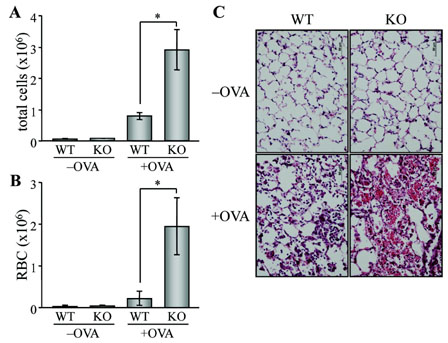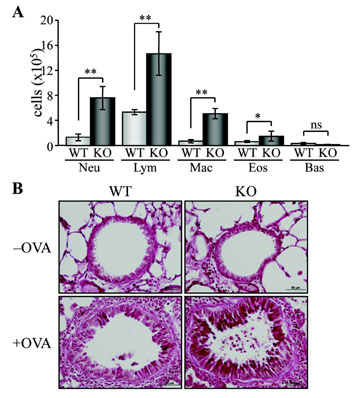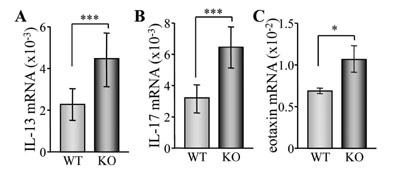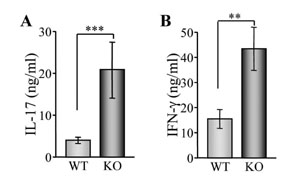Immune Netw.
2011 Jun;11(3):169-174. 10.4110/in.2011.11.3.169.
Enhancement of Allergen-induced Airway Inflammation by NOX2 Deficiency
- Affiliations
-
- 1College of Pharmacy and Division of Life and Pharmaceutical Sciences, Ewha Womans University, Seoul 120-750, Korea. eshwang@ewha.ac.kr
- KMID: 2150704
- DOI: http://doi.org/10.4110/in.2011.11.3.169
Abstract
- BACKGROUND
NADPH oxidase (NOX) modulates cell proliferation, differentiation and immune response through generation of reactive oxygen species. Particularly, NOX2 is recently reported to be important for regulating Treg cell differentiation of CD4+ T cells.
METHODS
We employed ovalbumin-induced airway inflammation in wild-type and NOX2-deficient mice and analyzed tissue histopathology and cytokine profiles.
RESULTS
We investigated whether NOX2-deficiency affects T cell-mediated airway inflammation. Ovalbumin injection which activates T cell-mediated allergic response increased airway inflammation in wild-type mice, as evidenced by increased immune cell infiltration, allergic cytokine expression, and goblet cell hyperplasia in the lung. Interestingly, NOX2 knockout (KO) mice were more susceptible to allergen-induced lung inflammation compared to wild-type mice. Immune cells including neutrophils, lymphocytes, macrophages, and eosinophils were drastically infiltrated into the lung of NOX2 KO mice and mucus secretion was substantially increased in deficiency of NOX2. Furthermore, inflammatory allergic cytokines and eotaxin were significantly elevated in NOX2 KO mice, in accordance with enhanced generation of inflammatory cytokines interleukin-17 and interferon-gamma by CD4+ T cells.
CONCLUSION
These results indicate that NOX2 deficiency favorably produces inflammatory cytokines by T cells and thus increases the susceptibility to severe airway inflammation.
MeSH Terms
-
Animals
Cell Proliferation
Cytokines
Eosinophils
Goblet Cells
Hyperplasia
Inflammation
Interferon-gamma
Interleukin-17
Lung
Lymphocytes
Macrophages
Mice
Mucus
NADPH Oxidase
Neutrophils
Ovalbumin
Pneumonia
Reactive Oxygen Species
T-Lymphocytes
T-Lymphocytes, Regulatory
Cytokines
Interferon-gamma
Interleukin-17
NADPH Oxidase
Ovalbumin
Reactive Oxygen Species
Figure
Reference
-
1. Groemping Y, Lapouge K, Smerdon SJ, Rittinger K. Molecular basis of phosphorylation-induced activation of the NADPH oxidase. Cell. 2003. 113:343–355.
Article2. Bedard K, Krause KH. The NOX family of ROS-generating NADPH oxidases: physiology and pathophysiology. Physiol Rev. 2007. 87:245–313.
Article3. Thannickal VJ, Fanburg BL. Reactive oxygen species in cell signaling. Am J Physiol Lung Cell Mol Physiol. 2000. 279:L1005–L1028.
Article4. Phillips DC, Dias HK, Kitas GD, Griffiths HR. Aberrant reactive oxygen and nitrogen species generation in rheumatoid arthritis (RA): causes and consequences for immune function, cell survival, and therapeutic intervention. Antioxid Redox Signal. 2010. 12:743–785.
Article5. Lambeth JD. NOX enzymes and the biology of reactive oxygen. Nat Rev Immunol. 2004. 4:181–189.
Article6. Jackson SH, Gallin JI, Holland SM. The p47phox mouse knock-out model of chronic granulomatous disease. J Exp Med. 1995. 182:751–758.
Article7. Pollock JD, Williams DA, Gifford MA, Li LL, Du X, Fisherman J, Orkin SH, Doerschuk CM, Dinauer MC. Mouse model of X-linked chronic granulomatous disease, an inherited defect in phagocyte superoxide production. Nat Genet. 1995. 9:202–209.
Article8. Segal AW. Absence of both cytochrome b-245 subunits from neutrophils in X-linked chronic granulomatous disease. Nature. 1987. 326:88–91.
Article9. Volpp BD, Nauseef WM, Clark RA. Two cytosolic neutrophil oxidase components absent in autosomal chronic granulomatous disease. Science. 1988. 242:1295–1297.
Article10. Lee K, Won HY, Bae MA, Hong JH, Hwang ES. Spontaneous and aging-dependent development of arthritis in NADPH oxidase 2 deficiency through altered differentiation of CD11b+ and Th/Treg cells. Proc Natl Acad Sci U S A. 2011. 108:9548–9553.
Article11. Chaplin DD. Cell cooperation in development of eosinophil-predominant inflammation in airways. Immunol Res. 2002. 26:55–62.
Article12. Thorbecke GJ, Umetsu DT, deKruyff RH, Hansen G, Chen LZ, Hochwald GM. When engineered to produce latent TGF-beta1, antigen specific T cells down regulate Th1 cell-mediated autoimmune and Th2 cell-mediated allergic inflammatory processes. Cytokine Growth Factor Rev. 2000. 11:89–96.
Article13. Herz U, Lumpp U, Daser A, Gelfand EW, Renz H. Murine animal models to study the central role of T cells in immediate-type hypersensitivity responses. Adv Exp Med Biol. 1996. 409:25–32.14. Hwang ES. Transcriptional regulation of T helper 17 cell differentiation. Yonsei Med J. 2010. 51:484–491.
Article15. Won HY, Sohn JH, Min HJ, Lee K, Woo HA, Ho YS, Park JW, Rhee SG, Hwang ES. Glutathione peroxidase 1 deficiency attenuates allergen-induced airway inflammation by suppressing th2 and th17 cell development. Antioxid Redox Signal. 2010. 13:575–587.
Article16. Park JW, Min HJ, Sohn JH, Kim JY, Hong JH, Sigrist KS, Glimcher LH, Hwang ES. Restoration of T-box-containing protein expressed in T cells protects against allergen-induced asthma. J Allergy Clin Immunol. 2009. 123:479–485.
Article17. Kiefmann R, Rifkind JM, Nagababu E, Bhattacharya J. Red blood cells induce hypoxic lung inflammation. Blood. 2008. 111:5205–5214.
Article
- Full Text Links
- Actions
-
Cited
- CITED
-
- Close
- Share
- Similar articles
-
- Allergen-induced airway inflammation and its therapeutic intervention
- Comparative study on the activation status of eosinophils in exerise- and allergen-induced asthma
- Interleukin-10 Reverse Allergen-Induced Airway Hyperreactivity and Inflammation
- Role of CD8 (+) T Cells in Airway Inflammation and Hyperresponsiveness
- Effect of Route of Airway Allergen Challenge on Airway Inflammation and Hyperresponsiveness in Mouse Asthma Model






